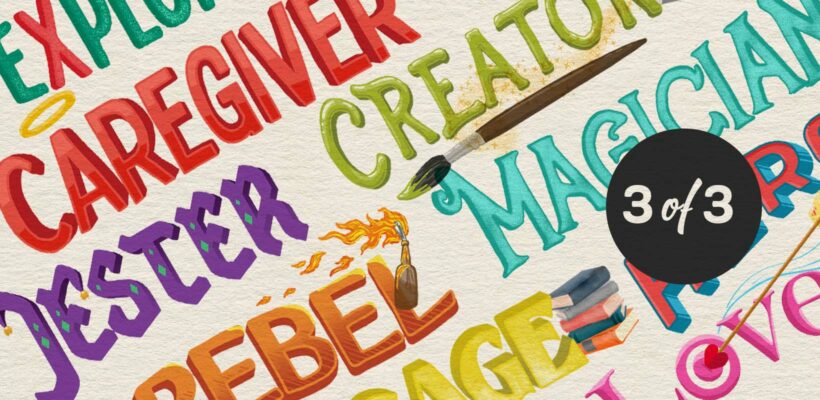
We just connect with some brands, don’t we? We have a bond and it’s hard to describe exactly why. It’s as if we know them. In some cases, it’s as if we love them.
For example, are you Coke or Pepsi? Chick-fil-A or Popeye’s? iPhone or Samsung?
What is it that attracts us to these brands and makes us feel so strongly? Why do we welcome them into our little worlds or show such loyalty towards them? Could it be a cool logo, clever writing or some kind of marketing magic? Nope. The answer? Brand archetypes.
As we’ve discussed in Intro to Brand Archetypes, brand archetypes are universal character types found in myths, songs and stories since time began. As humans, we instinctively recognize them. We know them in our bones and they feel familiar. They feel…right.
For business applications, use of archetypes reveal how a brand shows up in the world, how it is motivated, what triggers it into action and how it reacts.
So, how do you apply archetypes to your brand?
Once you’ve taken the time and done the work to dive deep and discover the archetype (or archetypes, but more on that strategy later) that resonate with your business, it’s time to flesh them out before applying them to your brand communications.
These are the details that help you really “see” your archetype, crafting the full persona.
- With the characteristics of each brand archetype in mind, define its opinions on issues related to your business.
- Identify its attitude towards life in general.
- Identify the appropriate tone of voice and writing style.
- Determine the vocabulary your brand archetype will use.
- Create brand visuals, colors, typography and images to represent this personality.
- Apply your vocabulary, opinions, attitudes and tone of voice to all of your brand communication.
Remember, as with a story, the more detail there is in your brand personality, the more vivid and memorable it will be.
See how real-world brands use archetypes.
Let’s zero in on a specific archetype that’s the dominant personality for a particular brand. Say… The Jester.
Now, the Jester is all about having fun and living life in the moment. They not only love having fun themselves, they see it as their duty to be a ray of sunshine for everyone around them. They are optimists and can’t be kept down long due to their ability to see the good in every situation. Jesters love to entertain through humor. Knowing this, its brand voice is playful, fun-loving and optimistic.
What are some jester brand archetypes out there? Let’s look at Dollar Shave Club…
Dollar Shave Club as the Jester.
Dollar Shave Club is an example of a brand who used characteristics of the Jester archetype to differentiate themselves from the market leader Gillette. They understood their audience, then reached out and connected with them by pointing to the high price and unnecessary features of the industry king Gillette, with a refreshing dose of wit, dry humor and “I don’t give a sh*t” attitude.
Successful? Their hilarious inaugural YouTube video was watched by three million people in a matter of days and put them on the map. Five years later they were sold to Unilever for a billion dollars, and today continue to use the much-loved Jester archetype characteristics to connect with their audience.
Dove as the Innocent.
Here’s another example of a brand that knows its dominant archetype. Dove has completely embraced the Innocent archetype. As a reminder, Innocents are all about happiness and simplicity. They seek out simple solutions that will bring them back to a happy equilibrium quickly and efficiently. They are also youthful and romantic, as well as faithful and optimistic, which help breed brand loyalty in customers.
Through the Innocent archetype, Dove has beautifully aligned themselves with the word “purity.” They boost the self-esteem in their female audience and promote the beauty and femininity in all women. Their personality is positive and encouraging, and they promote honesty and respect.
Here, they bring it right to the frontlines of the pandemic, changing the idea of what’s beautiful through the eyes of their brand archetype.
Apple as the Rebel. Oh, wait, the Creator.
To break into a market dominated by Microsoft, Apple (led by visionary Steve Jobs) went all out, adopting the personality of the Rebel, and encouraging their audience to break free from the shackles of the status quo in a little Super Bowl TV ad back in 1984.
Jobs left Apple in 1985, but in 1997, after Apple had lost its way, he was brought back in to save the company. He did just that, using his experience in storytelling backed by an even bigger vision of what Apple could be. Apple aligned itself with the Creator archetype, celebrating the innovators and difference-makers of the world from Pablo Picasso to Thomas Edison, and inspired the imagination of their audience.
Was Apple’s idea to “Think Different” ultimately successful? In January of 2022, Apple became the first U.S. company to reach a $3 trillion market cap.
👉 Dive into archetypes and how to use them to empower your brand.
Ready to explore your brand archetypes and understand how to use them to build your business?
Red Chalk would love to chat! Schedule a consultation and let’s put the power of brand archetypes to work creating a desirable brand.
If you want to explore the world of archetypes and how they are used in brand management, we highly recommend the book Archetypes in Branding: A Toolkit for Creatives and Strategists, written by Margaret Hartwell and Joshua C. Chen.


